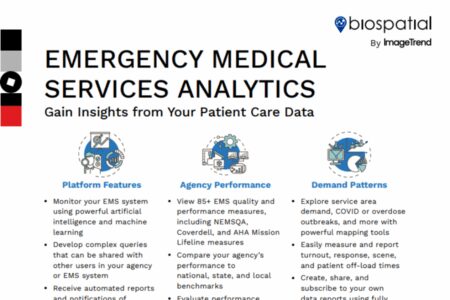Interoperability isn’t just a technical milestone, it’s a strategic imperative. When EMS and hospitals operate from a shared, near real-time view of the patient, we unlock faster decisions and better outcomes.
—Joe Graw, Chief Growth Officer, ImageTrend
In today’s healthcare environment, real-time data has become a necessity as EMS and hospital teams are navigating mounting pressure to deliver faster, more coordinated care. Yet too often, patient data remains trapped in disconnected systems, slowing decisions and compromising outcomes.
Interoperability offers a way forward, enabling EMS and hospital teams to work from a shared, up-to-date picture of every patient’s journey.
In Part 1 of this report series, we lay the groundwork, clarifying the differences between EMR, EHR, and ePCR, dispelling myths, and defining why EMR interoperability matters for EMS and hospital teams alike.
In Part 2, we explore how to implement interoperability in the real world by aligning people, systems, and workflows while navigating common challenges like missing demographic data or documentation delays.
In Part 3, let’s bring it all together with a walk-through of what success actually looks like. This isn’t a theoretical model. It’s a composite of real use cases made possible by ImageTrend’s all-in-one platform that supports them—proving that connected care is both essential and achievable.
Before the Call: The EMS-Hospital Interoperability Foundation Is Already in Place
True interoperability begins long before a 9-1-1 call is placed. It starts with a well-configured system and agency-wide commitment to data quality, clinical documentation, and structured exchange. EMS agencies using ImageTrend Elite™ have already built this foundation—using configurable run forms, built-in validations, and NEMSIS 3-compliant data fields to ensure every report is clear, complete, and ready for real-time sharing.
Hospitals in the network are also connected through ImageTrend’s Health Information Hub (HIH), a secure interoperability engine that facilitates bidirectional data exchange between prehospital ePCRs and in-hospital EMRs or EHRs, such as Epic or Oracle Health. HIH supports industry standards like HL7 to ensure reliable, secure transmission of patient information—without manual intervention.
EMS is no longer just the first touchpoint in emergency care—it’s a data rich contributor to the entire care continuum. Software tools that allow for real bidirectional data exchange have enabled EMS to lead the way in interoperability, not lag behind it.
—Joe Graw, Chief Growth Officer, ImageTrend
The Call Comes In: Real-Time Data at the Scene
An EMS crew is dispatched to an elderly patient in respiratory distress at a skilled nursing facility. Before arrival, the provider uses a secure, in-field connection to query the patient’s previous records. Thanks to HIH and its connection to national health information exchanges, the provider retrieves relevant patient history: a recent CHF diagnosis, current medication list, and an allergy to naproxen.
At the scene, the EMS crew quickly confirms the patient’s status with facility staff and documents vital signs, interventions, and timestamps using Elite’s intuitive field interface. The system auto-populates known repeat patient data, including previous EKG results and allergy information—reducing on-scene documentation time and cognitive load.
To further streamline reporting in the field, the EMS crew leverages AI-assist technology to reduce documentation fatigue and improve speed. Purpose-built for EMS, AI-assist combines intelligent voice-to-text, real-time field validation, and smart image recognition. The crew dictates clinical shorthand as structured data auto-populates across the report. AI-assist suggests likely values, flags inconsistencies, and learns from past report patterns to guide the crew through documentation faster. The crew can even scan documents—like a face sheet and medication list—to automatically extract and apply critical patient data, improving accuracy while saving time on scene and in transit.
The patient’s condition stabilizes after initial intervention. While en route to the hospital, the EMS crew continues to document their care and transmits it directly through HIH. The data arrives in the hospital’s EMR before the ambulance does.
At the Hospital: Continuity and Coordination
When the patient arrives at the ED, the receiving team has already reviewed the EMS assessments, vitals, and field treatments within their native EMR. No separate login. No printed handoff. Just real-time, structured data flowing directly from Elite into the hospital’s system via HIH.
This seamless connection eliminates duplicate documentation and accelerates decision-making. The ED team avoids ordering repeat labs and instead tailors care based on the field report and past medical history.
In the background, the patient is registered under the correct name, matched to a master patient index, and flagged for relevant care pathways based on the EMS record and facility integration.
Success in interoperability starts long before the call. Agencies that invest in data quality, structured documentation, and system alignment are the ones ready to deliver connected care when seconds count.
—Joe Graw, Chief Growth Officer, ImageTrend
After Discharge: Data Comes Full Circle
Within 48 hours of discharge, the hospital system transmits outcome data back to the EMS agency through HIH. The record includes diagnosis, key interventions, length of stay, and patient disposition—all tied back to the original ePCR via a unique identifier.
This feedback loop enables the EMS agency’s QA team to review outcomes, assess field interventions, and identify training opportunities. The data is not only used for internal quality assurance but also supports broader community health initiatives—such as identifying frequent utilizers, improving response protocols, and informing partnerships with public health or behavioral health agencies.
Orange County EMS, for example, has implemented this type of feedback model and achieved an 83% hospital outcome data return rate across more than 20 facilities. Their success has enabled smarter QA workflows, stronger hospital collaboration, and a more accountable system of care.
Why EMS-Hosptial Interoperability Matters Now
This scenario isn’t hypothetical—it’s what interoperability can and should look like. But too few systems have reached this level of integration, and those that haven’t risk falling behind.
Healthcare is shifting rapidly. Hospitals are under pressure to deliver coordinated, value-based care while often managing tighter budgets. At the same time, expectations for data-driven decision-making are higher than ever. In this environment, disconnected systems don’t just create inefficiency, they actively compromise care.
But with the right tools in place, EMS and hospital teams can reduce handoff friction, document more effectively, and build the data continuity that today’s healthcare demands. Interoperability is no longer a nice-to-have. It’s a foundation for operational resilience, clinical precision, and community impact.
EMS-Hospital Interoperability Is Today’s Reality—and Tomorrow’s Promise
What does ideal EMR interoperability look like? It looks like data that follows the patient, care teams that collaborate in real time, and agencies that learn and adapt from every outcome. It looks like the workflow we just walked through—powered by technology, supported by standards, and executed by teams with more time to provide better care.
If you’re ready to build the future of connected care, our team can help you define your goals, align your systems, and take the first step toward full-circle EMS-hospital interoperability.
Connect with a solution expert today to schedule a personalized demo.




